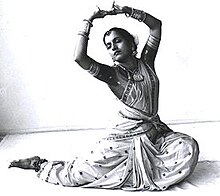Damayanti Joshi
Damayanti Joshi | |
|---|---|
 dancing | |
| Born | 5 September 1928 Mumbai, India |
| Died | 19 September 2004 (aged 76) Mumbai, India |
| Occupation(s) | dancer, choreographer, dance instructor |
| Career | |
| Dances | Kathak |
Damayanti Joshi (5 September 1928 – 19 September 2004)[1] was a noted renowned exponent of the Kathak dance form.[2] She believed Kathak is the art of storytelling.[2] She began in the 1930s dancing in Madame Menaka's troupe, which travelled to many parts of the world. She learnt Kathak from Sitaram Prasad of Jaipur Gharana and became an adept dancer at a very young age, and later trained under from Acchan Maharaj, Lacchu Maharaj and Shambhu Maharaj of Lucknow gharana, thus imbibing nuances from both the traditions. She became independent in the 1950s and achieved prominence in the 1960s, before turning into a guru at her dance school in Mumbai.[3][4][5]
She received the Padma Shri in 1970, the Sangeet Natak Akademi Award for Dance in 1968, and had remained Director of the U.P. Kathak Kendra in Lucknow.[6]
Early life and training
[edit]Born in a Hindu family in Mumbai in 1928,[7] she grew up in the household of General Dr Sahib Singh Sokhey and his wife Leila Sokhey (born Roy) who became known as Madame Menaka.[8] Manaka had lost her own child and she had decided to adopt Joshi. Joshi's mother Vatsala Joshi would not give up her daughter and they agreed to be joint guardians.[9] Initially performed in temples. [2]In Manaka's troupe she learnt about Kathak from Pandit Sitaram Prasad as she toured in Menaka's troupe. After ten years, when she was 15 she had performed in European major cities. The Sokheys employed Damayanti's mother and Joshi received an education.[6][10][9] Among her contemporaries at Madame Menaka's was Shirin Vajifdar, a pioneering classical dancer from the Parsi community.[11]
She was the first student at Mumbai's Sri Rajarajeswari Bharata Natya Kala Mandir, where she learned Bharat Natyam from Guru T. K. Mahalingam Pillai, doyen among nattuvanars.[12]
Career
[edit]After the mid-1950s, Damayanti established herself as a successful solo Kathak dancer, taking training from Pandits, Achhan Maharaj, Lachhu Maharaj and Shambhu Maharaj of the Lucknow gharana and Guru Hiralal of the Jaipur gharana. Particularly, at Kathak Kendra, Delhi, she trained under Shambhu Maharaj.[13] She was the first person to introduce "Saree" as a costume in Kathak dance.
She also taught Kathak at Indira Kala Vishvaidyalaya, Khairagarh, and Kathak Kendra in Lucknow. She has been honoured with the Sangeet Natak Akademi Award (1968) and the Padma Shri (1970).[14] She was also the guru to Bireshwar Gautam.
She has been featured in the documentary on Kathak in 1971 by Films Division, Government of India, and another film entitled "Damayanti Joshi" directed by Hukumat Sarin was made in 1973.[citation needed]
Damayanti Joshi died in Mumbai at her home on Sunday, September 19, 2004. She had been ailing and was bed-ridden for almost one year after she suffered a stroke attack.
In the passing away of this great dancer we lost a great wealth of knowledge which we can only hope was imparted to her students like Pt. Bireshwar Gautam who remained a faithful student, dedicated to her till her very end.[15]
Works
[edit]- Madame Menaka, by Damayanti Joshi. Sangeet Natak Akademi, 1989.[citation needed]
- Rediscovering India, Indian philosophy library: Kathak dance through ages, by Projesh Banerji, Damayanti Joshi. Cosmo publications, 1990.[citation needed]
See also
[edit]References
[edit]- ^ "Kathak FAQ: Short notes on the popular Kathak dancers". Nupur Nritya – Sangeet Academy. Archived from the original on 14 April 2010.
- ^ a b c "Damayanti Joshi | Films Division". filmsdivision.org. Retrieved 7 October 2021.
- ^ Kothari, Sunil (1989). Kathak, Indian classical dance art. Abhinav Publications. p. 188.
- ^ Massey, p. 64
- ^ Banerji, Projesh (1983). Kathak dance through ages. Humanities Press. p. 45.
- ^ a b "TRIBUTE: A life of intricate rhythms". The Hindu. 18 September 2005. Archived from the original on 11 November 2012.
{{cite news}}: CS1 maint: unfit URL (link) - ^ Menon, Rekha (1961). Cultural profiles, (Volume 2). Inter-National Cultural Centre. p. 17.
- ^ Giants Who Reawakened Indian Dance, Kusam Joshi, 2011, Hinduism Today, Retrieved 5 September 2016
- ^ a b Lakshmi, C.S. (7 November 2004). "A life dedicated to dance". The Hindu. Archived from the original on 25 March 2005.
- ^ Lakshmi, C. S.; Roshan G. Shahani (1998). Damayanti, Menaka's daughter: a biographical note based on the Visual History Workshop, February 15, 1998 Issue 8 of Publication (SPARROW). SPARROW. p. 11.
- ^ Kothari, Sunil (3 October 2017). "Remembering Shirin Vajifdar – Pioneer in All Schools of Dance". The Wire. Retrieved 4 October 2017.
- ^ "Life dedicated to dance". The Hindu. 3 January 2003. Archived from the original on 2 December 2008. Retrieved 13 October 2010.
{{cite news}}: CS1 maint: unfit URL (link) - ^ Massey, Reginald (1999). India's kathak dance, past present, future. Abhinav Publications. p. 29. ISBN 81-7017-374-4.
- ^ "Padma Awards". Ministry of Communications and Information Technology. Archived from the original on 10 July 2011.
- ^ "Obit / Profile - Damayanti Joshi passes away". narthaki.com. Retrieved 7 October 2021.
External links
[edit]- Kathak exponents
- 1928 births
- 2004 deaths
- Artists from Mumbai
- Teachers of Indian classical dance
- Recipients of the Sangeet Natak Akademi Award
- Recipients of the Padma Shri in arts
- Women educators from Maharashtra
- Indian dance teachers
- Indian female classical dancers
- Dancers from Maharashtra
- 20th-century Indian dancers
- 20th-century Indian women artists
- Women artists from Maharashtra
- Educators from Maharashtra
- 20th-century Indian educators
- 20th-century Indian women educators
